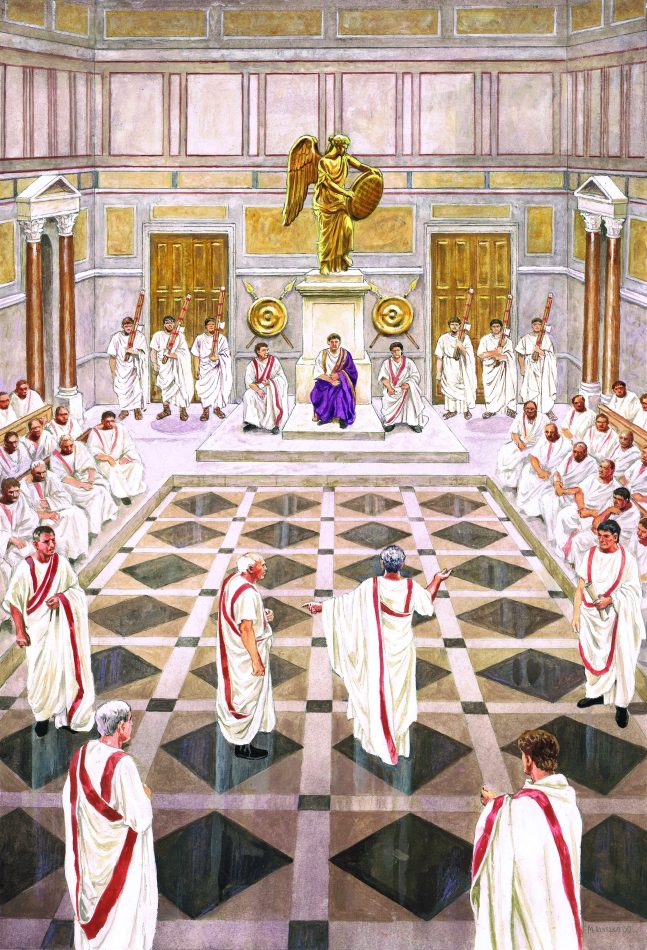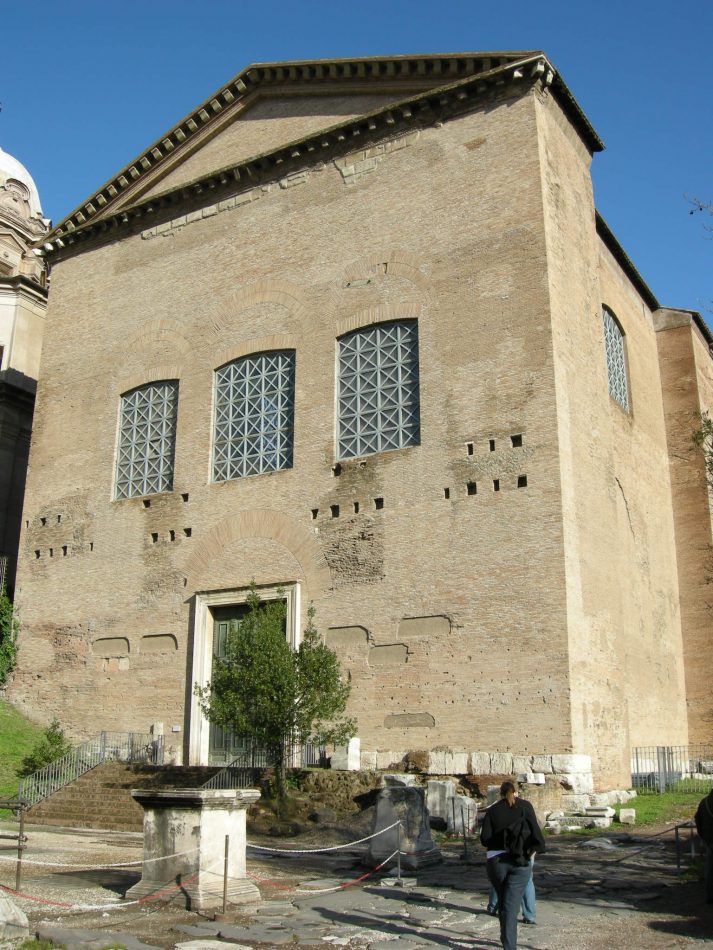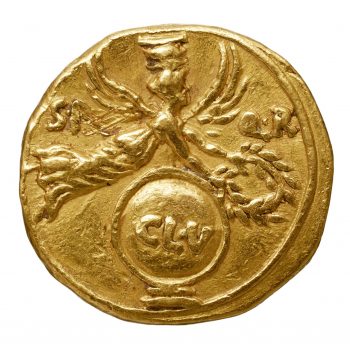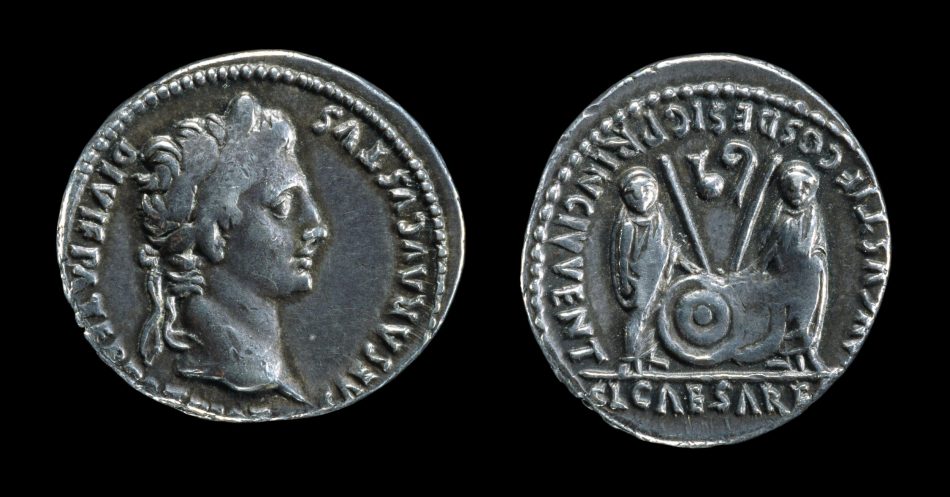Art on Trial
The feature article I wrote for Ancient History issue 30 is entitled ‘Avenging Germanicus: Ancient Rome’s Greatest Show Trial’. I was pleasantly surprised to learn that the editor had commissioned a painting to illustrate it. For this blog, I thought I would explain what the illustration shows and how the illustrator and I collaborated to create the finished artwork.

The Trial of Calpurnius Piso. ©Marek Szyszko 2020
I already had a clear concept of how the illustration should look. I wanted to recreate the scene in Tacitus, Annals 3.13 in which P. Vitellius delivers the indictment against Cn. Calpurnius Piso “with considerable eloquence” on the first day of the trial in December AD 20. (Fans of the BBC TV/PBS Masterpiece Theatre adaptation of Robert Graves’ novel ‘I, Claudius’ may recall the drama in episode 5 (‘Some Justice’) in which Stratford Johns played Piso, George Baker was Tiberius, and Patrick Stewart was Sejanus).
As a historian and writer, I have been fortunate to work with several world-class historical artists. This was my first project with Polish illustrator Marek Szyszko. As I do with all creative talent, I first assemble a file of art references. It provides the artist with my ideas and examples – artefacts, text, other art – to work from.
Normally, trials in ancient Rome took place in the Forum Romanum in the open air or in one of the basilicas. There were different courts for different types of cases. As Piso’s trial was a case of murder with poison suspected, it would usually have been heard before a chief magistrate (praetor) presiding over crimes of poisonings (de veneficiis). The murder charge was complicated by other grave offences. Piso was both a senator and a deputy of Tiberius Caesar, Rome’s second emperor. In this case, he was tried by his peers and fellow senators in Senate House (Curia Iulia). I recalled a scene in Fall of the Roman Empire (1964) in which Livius appeals to Emperor Commodus and a highly skeptical Senate to allow barbarian tribespeople to settle within the borders. The set designer had recreated the interior of the Curia Iulia as a stunning backdrop; however, for my purposes, many details were anachronistic or just wrong. Fortunately, many of the historical and architectural details of the first century AD are known.

Exterior of a Curia Iulia, Rome. ©Sailko, Wikimedia Commons
Located in a corner of the Forum Romanum, this building replaced an earlier structure destroyed by fire. The work began in 44 BC under Julius Caesar and was inaugurated by Augustus in 29 BC. He dedicated it to the Julian clan of his murdered father, of which he was now a member by inheritance (Augustus, Res Gestae 19; Dio, Roman History 51.22.1; Suetonius, Caligula 60). Remarkably the building still stands. The hall is 25.2 metres long by 17.6 metres wide, and 21.0 metres high. The structure is constructed of red brick, but the interior was originally covered with panels of marble about two-thirds of the way up; they were stripped in later ages, so its appearance in our illustration is conjectural. Windows high up in the structure, front and sides, provide natural light.
The design of the Curia Iulia’s interior is simple but highly functional for the needs and procedures of the people working there. The floor plan may surprise some readers. Seating is arranged parliamentary-style, not in the curved theatre-style depicted in so many modern films and paintings. Along the two longer sides of the hall are three wide steps. Chairs or benches line these, 50 men per row, for a total of 300 senators – the same number who passed the verdict in the trial in AD 20.
The geometric floor pattern, with its expensive polychrome marble slabs, echoes the restrained style of the flooring laid in the adjacent Forum Augustum. I particularly like how Marek evoked the polished surface, which reflects the standing figures. Unlike modern parliaments, the Curia was a dynamic debating space. A speaker rose and took the floor. As I write in my Marcus Agrippa (Pen and Sword Books, 2015):
The membership of the Senate, referred to deferentially as Patres Conscripti, ‘Conscript Fathers’, comprised of serving and former magistrates … Current magistrates represented a small number of the members, and those who had served as junior magistrates were called senatores pedarii because they were not permitted to speak, but shuffled from one side of the Senate House to the other to show their support of a speaker.
All of the senators wear the national Roman dress of tunica and toga made of homespun wool, but with red, maroon or purple stripes to indicate their high social rank. Many are current magistrates with imperium (legal power), such as aediles, censors, praetors, quaestors and tribunes, while others are former officials, proconsuls and propraetors. Once a member of the Senate it is for life.
In the illustration, the lead prosecutor, P. Vitellius, is speaking, accusing the defendant, Cn. Calpurnius Piso. Trained in rhetoric, a speaker emphasised points in his speech with a repertoire of well-practiced, dramatic gestures. The other standing figures are members of the prosecution team. The man on the right with black hair is Drusus Iulius Caesar, the emperor’s own son.
Dominating the trial proceedings is the altar to Victoria dedicated to the personification of military victory. The gold statue – actually gilt bronze – has long since vanished. We know of its existence, however, because it is mentioned in a text, and because it is depicted on coins. Suetonius writes of the funeral of Caesar Augustus (AD 14):

Victoria shown on a coin flying and placing a crown on the clipeus virtutis. BnF Collection: IMP-4771 ©Wikimedia Commons
In their desire to give him a splendid funeral and honour his memory the Senators so vied with one another that among many other suggestions some proposed that his cortège pass through the triumphal gate, preceded by a statue of Victory which stands in the House… (Suetonius, Life of Divus Augustus 100.2).
Some Roman coins show the winged goddess standing on top of a globe – others show her flying – and extending a laurel wreath in her outstretched hand, and holding a shield. The statue stands on an altar, which was placed in the Curia by Augustus to celebrate his victory at the Battle of Actium in 31 BC during which he defeated his rivals M. Antonius and Queen Kleopatra. (A statue of Victory also crowned the exterior of the building, standing atop the front pediment). We based our illustration on the image of Victory writing on a shield depicted on Trajan’s Column.
In 27 BC Augustus was awarded a golden shield (Clipeus Virtutis). The shield was a Greek-style aspis, the large round shield originally carried by Greek hoplite infantry. It bore an inscription recognising his four ‘manly virtues’ (Augustus, Res Gestae 34), usually indicated on coins as ‘CL V’. The exact words are preserved on a copy in marble found in Arles, France:
SENATVS
POPVLVSQVE ROMANVS
IMP CAESARI DIVI F AVGVSTO
COS VIII DEDIT CLVPEVM
VIRTVTIS CLEMENTIAE
IVSTITIAE-PIETATIS-ERGA
DEOS PATRIAMQVE
The Senate
and Roman People
dedicate this Shield of Virtue to
Emperor Caesar Augustus, Son of God,
Consul Eight Times,
for Works of Clemency
Justice, Piety
to the Gods and the Fatherland.

Gaius and Lucius Caesar, on left and right, standing front, each togate and resting hand on shield; behind each shield, a spear; above, simpulum right (on left) and lituus left (on right). (reverse). Head of Augustus, laureate, right. (obverse). ©Trustees of the British Museum
Two shields hang beside the altar. They once belonged to Caius and Lucius Caesar, the sons of Augustus who he adopted from Agrippa in 17 BC. The boys were seen as the successors of Augustus. These round shields are depicted on coins. The shields are distinctly embossed with concentric circles. The shields and spears, covered with gold, were given to each boy on his the coming of age (in 5 BC and 2 BC respectively) when they also became princepes iuventutis, ‘youth leaders’:
And the golden targets and spears, which they had received from the knights on entering the class of youths of military age, were set up in the Senate House. (Dio, Roman History 55.12.1).
The lives of the young men were tragically cut short. Lucius died in AD 2 from sickness while on military manoeuvres, and Caius died in AD 4 from wounds sustained in war. Their loss was mourned by Augustus and the Roman People. I decided it was artistically pleasing to mount them on a wall behind the consuls, below the statue of Victory.
Augustus’ successor, Tiberius Caesar, is the figure in the purple toga with gold embroidery. He is seated between the two consuls, M. Valerius Messala Barbatus and M. Aurelius Cotta Maximus Messalinus, who served full terms in office in AD 20. Sitting this way was the fashion adopted by Augustus since 19 BC when he was appointed:
consul for life, and in consequence had the right … to sit in the curule chair between the two men who were at the time consuls. (Cassius Dio, Roman History 54.10.5).
While technically princeps Senatus, the ‘first man of the Senate’, Tiberius had decided before the trial not to be the presiding magistrate. Instead he merely attended to observe the proceedings – a position he often took in treason cases. Someone else would be the praetor urbanus presiding over the trial and consider the quaestiones, the charges under inquisition. In the picture he is the figure on the left, bottom row closest to the consuls. At the end of the trial, he will submit to a vote of the Senate the relatio, the final report and recommendations of the court. That vote will result in the publication of the Senate’s decree known as the Senatus Consultum de Cn. Calpurnius Piso Patre (SCPP) prepared by Tiberius’ quaestor. (Not shown in the illustration is the scribe recording the speeches; he is out of view, below our vantage point).

Statuette of a lictor. Antikensammlung München ©Jona Lendering
Flanking the Altar of Victory and carrying ceremonial bundles of axes and rods (fasces) are six lictores dressed in plain white togas. Paramilitary bodyguards and agents of the magistrate they serve, they clear a pathway for him through crowds when he walks in public, and they are empowered to summon and punish offenders for him. Normally each consul was escorted by twelve lictors, while a praetor (of whom there were 12 in total) was escorted by just six. If they all showed up at the same time that would be 96 bodyguards to squeeze into the picture! For the painting I imagined the lictores guarding the entrances – inside and outside the building – and placed just six of them in view.
All visual reconstructions of ancient buildings and events involve informed guesswork, using the available sources and evidence to evoke the occasions. Not shown in the illustration, for instance, are the two paintings Augustus had hung in the building, which are described in great detail by Pliny the Elder in Natural History 35.10.
My verdict? Overall, I think Marek did a fabulous job of reimagining this infamous Roman trial. How the hearing went for the defendant 2,000 years ago you can read about in the issue of Ancient History magazine.
About the author
Lindsay Powell is news editor of Ancient History and Ancient Warfare and author of Germanicus (Pen and Sword Books).
Love ancient history? Want to learn more?




